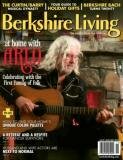
DANCE REVIEW: Paul Taylor at the Mahaiwe
Dance
May 29, 2010
Program: Public Domain, Brief Encounters and Piazolla Caldera; choreography by Paul Taylor
By Nichole Dupont
 (GREAT BARRINGTON, Mass.) – The internationally-acclaimed Paul Taylor Dance Company, now in its 56th season, graced the stage of the Mahaiwe Performing Arts Center last night, in a program showcasing the veteran choreographer’s ability to shape and mold abstract concepts using the very tangible, athletic bodies of his dancers, and, of course, modern dance.
(GREAT BARRINGTON, Mass.) – The internationally-acclaimed Paul Taylor Dance Company, now in its 56th season, graced the stage of the Mahaiwe Performing Arts Center last night, in a program showcasing the veteran choreographer’s ability to shape and mold abstract concepts using the very tangible, athletic bodies of his dancers, and, of course, modern dance.
Public Domain, first performed in 1968, was set to a cacophonous score (arranged by John Herbert McDowell) of jazz, Gregorian chants, 1940s German lounge music, symphonic arias, and movie dialogue all blasting through crackling speakers. The dance, much like the score, was spastic at times, as the dancers jerked and gyrated as if in a trance beyond their control. The effect of this, in addition to the monochromatic body suits, was circus-like and irreverent; the dancers, when they were not in halting motion, held awkward, humorous poses.
In contrast to the playful androgyny of Public Domain, the second program, Brief Encounters, set to Claude Debussy’s Le Coin des Enfants (orchestrated by Andre Caplet), was a sensual feast of movement and muscle. The dancers, wearing only black underwear, flitted in fluid, circular motions, laying light hands on each other for just a moment then gracefully moving away in a dance that signified the fleeting nature of lust and discovery.
Each touch, while clearly sexual as hands were gently laid on buttocks, also seemed to be an awakening, as the dancers pushed and pulled and chased and ran in elegant unison complimented by the almost primal, experience of bare skin and elongated muscle.
The lust demonstrated in Brief Encounters carried over into the third and final program Piazzolla Caldera, first performed in 1997. Set to the sexy strains of Astor Piazzolla and Jerzy Peterburshsky, the dance began with a smoky stage and dramatic lighting set above dancers dressed in black pinstriped pants, flowing flamenco dresses and thigh-high black stockings, evoking a Buenos Aires nightclub.
In the first movement, El Sol Sueno, which featured the full cast, men and women danced in pairs exhibiting the sharp, calculating, highly sexualized movements of a tango. These dramatic starts and stops gave way to the more frantic second and third movements, Concierto Para Quintelo and Celos, in which the stylized, sexy nuance of the dance transformed into vulnerability and longing. Two drunken men leaned languidly against each other, their movements lazy and careless, that is, of course, until a couple, entangled in a passionate frenzy, crossed the stage. Suddenly, the desire for passion, perhaps even love, is too great, and with more urgent, competitive movements, arms wide open and flexed, gives way to defeat as the dancers end up in an exhausted pile on the floor.
The program ended with Escualo, where the full cast once again came together, but this time instead of the prowling, controlled dance of the first movement, the dancers were less composed. It became clear that the passion literally swayed their movements from suave to intoxicated. Sleek chignons became mussed, and the elegant line of a woman’s straight back became sweaty and bent as she was lifted high into the air against her own will, a very visceral display of violence inspired by passion. The couples were no longer paired neatly but moved confusedly from partner to partner, this vulnerability of jerking glances, spinning and foot stomping a far cry from the finesse of the opening movement.
In the end, as the lights dimmed and Piazzolla’s accordion worked the dancers into an exhausted frenzy of quick steps and flexed bodies, it was clear that control, when faced with lust and want, would never prevail.
Nichole Dupont is editorial assistant at Berkshire Living.
Bookmark/Search this post with:

 Delicious
Delicious Digg
Digg StumbleUpon
StumbleUpon Propeller
Propeller Reddit
Reddit Magnoliacom
Magnoliacom Newsvine
Newsvine Technorati
Technorati
